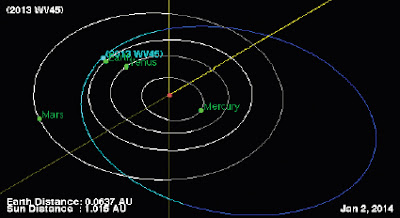Asteroid 2013 WV45 passed by the Earth at a distance of 9 143 000 km (a little under 24 times the average distance between the Earth and the Moon), slightly after 2.20 pm GMT on Friday 27 December 2013. There was no danger of the asteroid hitting us, and had it done so it would have presented little threat. 2013 WV45 is calculated to be between 20 and 62 m in diameter, and an object of this size would be predicted to break up in the atmosphere between 22 and 5 km above the ground, with only fragmentary material reaching the Earth's surface.
The calculated orbit of 2013 WV45. JPL Small Body Database Browser.
2013 WV45 was discovered on 29 November 2013 by the University of Arizona's Mt. Lemmon Survey at the Steward Observatory on Mount Lemmon in the Catalina Mountains north of Tucson. The designation 2013 WV45 implies that the asteroid was the 1146th object discovered in the second half of November 2013 (period 2013 W).
While 2013 WV45 occasionally comes near to the Earth, it does not actually cross our orbital path. It has an elliptical 922 day orbit that takes it from 1.01 AU from the Sun (1.01 times the distance at which the Earth orbits the Sun), slightly outside our orbit, to 2.69 AU from the Sun, (2.69 times the distance at which the Earth orbits the sun and considerably outside the orbit of the planet Mars), so unless an encounter with another body causes it's orbital path to alter in a very specific way (highly unlikely) there is no chance of it hitting the Earth. As a Near Earth Object that remains strictly outside the orbit of the Earth it is classed as an Amor Family Asteroid.
See also Asteroid 2013 YC14 passes the Earth, Asteroid 2013 WD44 Passes the Earth, Asteroid 2013 XA4 passes the Earth, Asteroid 2013 XY20 passes the Earth and Asteroid 2013 XW8 passes the Earth.
Follow Sciency Thoughts on Facebook.

